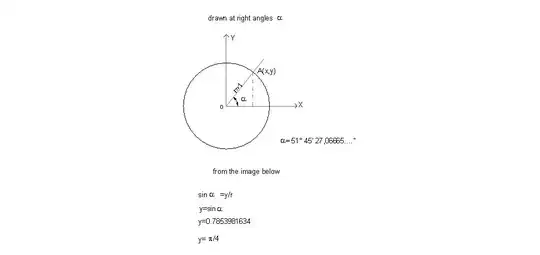This is not really an answer to the question you asked, but it is an answer to a question you could have asked: What good is the unit circle? What follows is a slight revision of some comments I've posted two or three times in the past few years in a listserv for (mainly U.S. high school) AP-calculus teachers.
By "unit circle", I mean a certain conceptual framework for many important trig facts and properties, NOT a big circle drawn on a sheet of paper that has angles labeled with degree measures 30, 45, 60, 90, 120, 150, etc. (and/or with the corresponding radian measures), along with the exact values for the sine and cosine of these angles.
I've found that an appropriate understanding of the unit circle gives a huge savings on memorization in that it allows you to efficiently catalogue and cross-check a large number of pertinent facts about the trig functions. All you have to know is that cosine goes with the $x$-coordinate and sine goes with the $y$-coordinate, and for this you just remember that it's alphabetical: *c*osine goes with $x$ and *s*ine goes with $y$.
Using this understanding of the unit circle, we can get the values of sine and cosine at integer multiples of 90 degrees, since these will correspond to points on the unit circle that are on the positive $x$-axis, the negative $x$-axis, the positive $y$-axis, or the negative $y$-axis, and for each of these possibilities we know what both coordinates of the point will be.
Using this understanding of the unit circle, we know that $\cos^{2} x + \sin^{2} x = 1$, from which so much else arises. (Essentially
everything if you work hard enough. See [1] [2].)
[1] Andy Roy Magid, "Trigonometric identities", Mathematics Magazine 47 #4 (September 1974), 226-227.
[2] David Earl Dobbs, "Proving trig. identities to freshpersons", Mathematics and Computer Education 14 #1 (Winter 1980), 39-42.
Using this understanding of the unit circle, we can get the signs of sine and cosine in each of the 4 quadrants.
Using this understanding of the unit circle, we can deduce that $\sin(-\theta) = -\sin(\theta)$ and $\cos(-\theta) = \cos(\theta)$. [In practice, when you know each of sine and cosine is either an even function or an odd function and you know about graph reflection properties for even and odd functions, it's easy to figure out which is which by looking at how the $x$- and $y$-coordinates for $-45$ degrees compare with the $x$- and $y$-coordinates for 45 degrees.]
Using this understanding of the unit circle, we know, when given an interval, whether sine is increasing on that interval, decreasing on that interval, or neither. We also know this for cosine. [In fact, since just to the right of $0$ sine is increasing and cosine is decreasing and both are positive, it follows that cosine is the one you have to use a negative sign for when writing its derivative. That's assuming you remember the derivative of the sine is cosine and the derivative of the cosine is sine, modulo one of them requiring a negative sign. I didn't expect (nor ever see) this from students, however.]
By considering a right triangle with one vertex at the origin, one vertex on the $x$-axis between $x=0$ and $x=1$, and one vertex on $x^2 + y^2 = 1$ in the first quadrant, you can see that sine and cosine are opp/hyp and adj/hyp, respectively.
You can even obtain the sine and cosine of 30 degrees, 45 degrees, and 60 degrees if you know that $\frac{1}{2}$ shows up as a value for at least one of them. Let's first consider the case where the $y$-coordinate of a first quadrant point on the unit circle is equal to $\frac{1}{2}$. Then we get $x^2 + \left(\frac{1}{2}\right)^2 = 1$, which gives us $x = \frac{\sqrt{3}}{2}$. Since $\frac{\sqrt{3}}{2} > \frac{1}{2}$ (square both sides, or just note that $\sqrt{3} > 1$), it must be that these are the values for a point $(x,y)$ on the unit circle such that $x > y$, so this has to be for 30 degrees (given that we know $\frac{1}{2}$ can be the value of sine and/or cosine only for first quadrant angles among those with degree measure 30, 45, 60). Since $x = \frac{1}{2}$ and $y = \frac{\sqrt{3}}{2}$ also satisfies $x^2 + y^2 = 1$ (no work needed; just switch the order of addition in the previous case), and here $x < y$, these must be the values for 60 degrees. (Or reflect our earlier $x > y$ situation about the line $y=x$, which is equivalent to a 90 degree counterclockwise rotation followed by a reflection across the vertical axis.) As for the values at 45 degrees, clearly this is when $x = y$, which you can easily substitute into $x^2 + y^2 = 1$ and get $x = y = \frac{\sqrt{2}}{2}$. No, I didn't expect any students to do this, nor did any of them do so to my knowledge. I'm just showing how much you can get from the unit circle with a bit of ingenuity and a few scraps of incompletely remembered results (such as one of the outputs being $\frac{1}{2}$).

